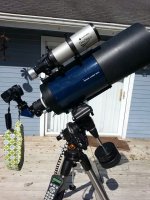Hi Don,
That telescope is not suitable for astrophotography. It has the wrong kind of mount. The mount pictured in the ad is an Alt-Azimuth mount. What you need is a telescope with an equatorial mount so it can track the stars as they move across the sky. Also, even if that mount were an equatorial mount, it is not heavy enough to carry the telescope + a camera without vibration.
Like anything else, before you can run, you need to walk. Starting out trying to photograph small faint galaxies is very difficult. There is much to learn. You need to align your telescope to the pole accurately - the longer the focal length, the more accurate your alignment must be. You will need to learn the star drift method for aligning your telescope. You also need to learn how to use the telescope. Before you can photograph something, you first need to find it

. This is not as easy as you would think and takes knowledge of the heavens as well as practice. You can use a GoTo mount, but these are expensive - expect goto functionality to add $1500 to $2000 to the price of the telescope mount.
For something like a faint galaxy, you also need to constantly guide the telescope as alignment is never perfect. Generally, this is accomplished by piggy-backing smaller telescope on your main telescope and using the second telescope for guiding. There are auto-guiders you can use, but again they are expensive.
Finally ( well actually not finally, there are many other things to consider ) if you're serious about astrophotography, you're better off buying a special purpose astrocamera instead of using your DSLR. They're lighter and usually have facilities for cooling the sensor to reduce noise.
A good starting point would be to get a fast prime lens - something 300mm or up and f/4 or faster, and piggy back it on your telescope. Using this setup, you can get very good pictures of some of the brighter nebulae and the Andromeda galaxy while you hone your astronomy skills.
This site:
Astrophotography Techniques has some basic information. This forum site:
Cloudy Nights Home would be an excellent place to post your question. There are many very knowledgeable people on it that will be happy to help you.
I'm not trying to discourage you here, it's just that it is very easy to be misled by advertising into buying equipment that doesn't work very well, frustrates you and wastes your money.

